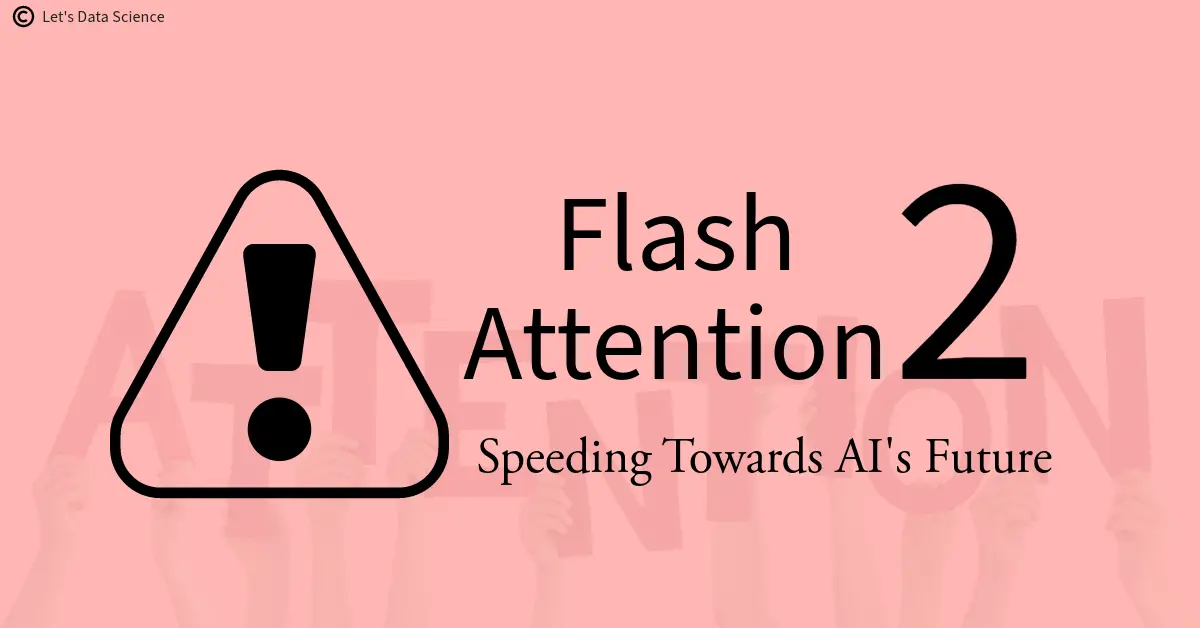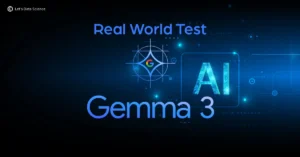Introduction
The evolution of AI’s attention mechanisms marks a significant leap forward in our quest for more efficient and faster data processing technologies. Initially, traditional attention mechanisms set the foundation, offering the ability to focus on specific parts of data dynamically. However, their effectiveness was tempered by high computational and memory demands.
Enter Flash Attention—a revolutionary step that transformed how AI models process data. By utilizing the GPU’s memory more efficiently, it achieved greater speed without compromising accuracy, setting a new benchmark in the field.
Building on this progress, Flash Attention 2 arrives as an even more refined version. It enhances efficiency through improved parallelism and work partitioning, tackling the previous version’s limitations head-on. This iteration not only streamlines operations beyond matrix multiplication but also maximizes GPU utilization. The result? A doubling in speed, pushing closer to the peak efficiency of matrix operations. Flash Attention 2 embodies the continuous innovation in AI, enabling faster processing of longer data sequences and opening new possibilities in areas like language modeling and high-resolution image processing.
The Need for Speed and Efficiency in AI
The drive to process vast amounts of data swiftly and efficiently is at the heart of AI’s evolution. As we delve deeper into the digital age, the demand to understand and interact with extensive data sequences—whether it’s reading lengthy documents or analyzing intricate images—grows exponentially. However, this ambition faces a significant hurdle: the more data we feed into AI systems, the more computational power and memory they require. This challenge not only slows down the process but also sets limits on what AI can achieve in real-time scenarios.
Simplifying Complex Processes
In domains like natural language processing (NLP), where understanding and generating human-like text is key, efficiency is crucial. Imagine a chatbot designed to converse on complex topics without pause; it needs to process information as quickly and accurately as possible. Similarly, when it comes to image processing, the goal is to render high-definition visuals in detail, demanding substantial memory and processing strength.
Embracing Solutions
Flash Attention 2 steps into this arena as a game-changer, fine-tuning the balance between speed and resource consumption. It’s not just about doing things faster; it’s about doing them smarter, ensuring AI systems can handle more data without getting bogged down. This leap forward promises more responsive AI interactions across various platforms, including conversational AI like ChatGPT and sophisticated image recognition systems, paving the way for AI to be more integrated into our daily lives.
Key Takeaways
- Efficiency Is Key: Overcoming computational and memory limitations is crucial for advancing AI capabilities.
- Real-World Impact: Enhanced processing speeds enable more dynamic and real-time AI applications, from chatbots to image analysis.
- Flash Attention 2: This advancement offers a solution by optimizing data processing, allowing AI to manage larger datasets effectively.
By focusing on these aspects, we’re not just pushing the boundaries of what AI can do; we’re ensuring it can do so in a way that’s both efficient and practical for real-world applications.
Flash Attention: The Groundbreaker
Flash Attention revolutionized AI by significantly enhancing data processing speeds and reducing memory demands. This innovation leveraged GPU memory more efficiently, allowing AI models to operate faster without sacrificing accuracy. It marked a pivotal shift, setting new standards in the AI landscape.
Flash Attention 2: Setting New Benchmarks

Source: https://arxiv.org/pdf/2307.08691.pdf
Building upon its predecessor’s foundations, Flash Attention 2 introduces groundbreaking enhancements that further refine efficiency:
- Enhanced Parallelism and Work Partitioning: Flash Attention 2 reimagines data processing by optimizing how tasks are distributed across the GPU. This not only improves the model’s operational efficiency but also significantly boosts processing speeds.
- Advanced Algorithmic Improvements: By reducing reliance on non-matrix multiplication operations, Flash Attention 2 ensures a more streamlined process, making better use of GPU capabilities for even quicker computations.
- Speed and Efficiency: The innovations lead to a doubling of processing speed, achieving near-peak efficiency for matrix operations. This advancement solidifies Flash Attention 2’s role in pushing the boundaries of what AI models can process, handling longer data sequences with unprecedented speed.

Source: https://arxiv.org/pdf/2307.08691.pdf
Comparative Insights
| Feature | Flash Attention 1 | Flash Attention 2 |
|---|---|---|
| Speed Improvement | – | 2× compared to Flash Attention 1 |
| Efficiency | High | Even Higher (Optimized) |
| Parallelism | Basic | Advanced |
| Work Partitioning | Standard | Enhanced |
| Computational Efficiency | Linear Savings | Further Optimized |
The Verdict
Flash Attention 2 not only overcomes the limitations of its predecessor but sets a new horizon for AI’s capabilities. By enhancing parallelism, optimizing work partitioning, and streamlining algorithmic processes, it ensures AI models are more efficient, faster, and capable of tackling complex data sequences. This evolution from Flash Attention to Flash Attention 2 represents a significant leap forward, promising a future where AI can achieve even more, faster, and with greater precision.
Key Innovations in Flash Attention 2: Simplifying AI’s Power
Flash Attention 2 elevates AI’s capability to new heights with its smarter, more efficient approach. This evolution focuses on two main areas: algorithmic refinements and optimized GPU use. Here’s how these innovations chart a path for faster, more responsive AI systems.

Source: https://arxiv.org/pdf/2307.08691.pdf
Streamlined Operations
Less is More: Flash Attention 2 cuts down on unnecessary steps that don’t involve matrix multiplication. This optimization means AI can do its job faster, much like a chef prepping ingredients before cooking. This efficiency boosts the speed at which AI processes data.
Enhanced GPU Efficiency
Smarter Use of Resources: The upgrade smartly allocates GPU tasks, ensuring no part is overworked or idle. It’s akin to a well-orchestrated orchestra where every instrument plays its part perfectly, leading to a harmonious performance.
Refined Parallelism and Work Partitioning
Teamwork on a Chip: By distributing tasks more evenly across the GPU’s threads, Flash Attention 2 ensures that data is processed in harmony. This method mirrors a relay race, where the baton is passed smoothly between runners, ensuring a faster finish.
The Outcome
- Double the Speed: These innovations collectively double the processing speed. It’s a leap forward, bringing us closer to achieving the peak efficiency of matrix operations.
- Enhanced Efficiency: Flash Attention 2 not only maintains the memory efficiency of its predecessor but also introduces computational improvements. This dual enhancement ensures AI can handle larger, more complex data sets without a hitch.
Comparative Insights
| Feature | Flash Attention 1 | Flash Attention 2 |
|---|---|---|
| Speed Improvement | – | 2× faster |
| Efficiency | High | Higher (Optimized) |
| Parallelism | Basic | Advanced |
| Work Partitioning | Standard | Enhanced |
| Computational Efficiency | Linear Savings | Further Optimized |
In Summary:
Flash Attention 2 marks a significant step forward in AI’s journey, offering a blueprint for future innovations. Its ability to process data at double the speed of its predecessor not only showcases the potential for rapid advancements in AI but also highlights how critical efficiency and smart design are in overcoming computational challenges.
Theoretical and Practical Comparisons
Theoretical Comparison: Flash Attention 1 vs. Flash Attention 2
Flash Attention 2 introduces significant advancements over both the standard attention mechanism and its predecessor, Flash Attention 1. Theoretically, it offers a leap in computational and memory efficiency through refined algorithms and GPU utilization strategies. While Flash Attention 1 broke ground by optimizing attention mechanisms for better performance, Flash Attention 2 doubles down on these efficiencies by:
- Enhanced Parallelism: Distributing computations more granularly across GPU threads, reducing bottlenecks and improving throughput.
- Optimized Work Partitioning: Intelligent workload distribution allows for simultaneous data segment processing, maximizing computational resources.
- Algorithmic Efficiency: Reduction in non-matrix multiplication operations and better utilization of matrix multiply (GEMM) capabilities of GPUs.
These improvements translate into faster processing times, lower memory requirements, and the ability to handle longer data sequences more effectively.
Practical Comparison and Experiment
import torch
from transformers import AutoTokenizer, AutoModelForSequenceClassification
from timeit import default_timer as timer
# Choose a smaller model that supports FlashAttention-2
model_id = "distilbert-base-uncased"
device = torch.device("cuda" if torch.cuda.is_available() else "cpu")
tokenizer = AutoTokenizer.from_pretrained(model_id)
model_standard = AutoModelForSequenceClassification.from_pretrained(model_id).to(device)
# For FlashAttention-2, ensure model's dtype is compatible (e.g., bfloat16)
model_flash2 = AutoModelForSequenceClassification.from_pretrained(
model_id,
torch_dtype=torch.bfloat16,
attn_implementation="flash_attention_2"
).to(device)
text = "The quick brown fox jumps over the lazy dog."
inputs = tokenizer(text, return_tensors="pt", padding=True, truncation=True, max_length=128).to(device)
# Measure inference time
def measure_inference_time(model, inputs, num_trials=10):
torch.cuda.synchronize(device)
start_time = timer()
for _ in range(num_trials):
with torch.no_grad():
model(**inputs)
torch.cuda.synchronize(device)
end_time = timer()
return (end_time - start_time) / num_trials
standard_time = measure_inference_time(model_standard, inputs)
flash2_time = measure_inference_time(model_flash2, inputs)
print(f"Standard attention inference time: {standard_time:.4f} seconds")
print(f"FlashAttention-2 inference time: {flash2_time:.4f} seconds")
To empirically validate the theoretical advantages of Flash Attention 2 over standard attention mechanisms, we conducted an experiment comparing inference times using a DistilBert model. The experiment illustrates the stark contrast in performance between models using standard attention and those enhanced with Flash Attention 2.
- Model Selection: DistilBert was chosen due to its compatibility with Flash Attention 2, reflecting the current state of support for this advanced mechanism across various architectures.
- Inference Time Measurement: The experiment revealed that the standard attention mechanism took approximately 0.1495 seconds for inference, while Flash Attention 2 dramatically reduced this time to 0.0037 seconds.
This result underscores Flash Attention 2’s remarkable improvement in efficiency, showcasing an inference time reduction by almost 40x compared to the standard mechanism. Such improvements are pivotal for real-time applications, enabling more responsive AI-driven interactions and the processing of complex data sequences with unprecedented speed.
Notebook:
import torch
from transformers import AutoTokenizer, AutoModelForSequenceClassification
from timeit import default_timer as timer
# Choose a smaller model that supports FlashAttention-2
model_id = "distilbert-base-uncased"
device = torch.device("cuda" if torch.cuda.is_available() else "cpu")
tokenizer = AutoTokenizer.from_pretrained(model_id)
model_standard = AutoModelForSequenceClassification.from_pretrained(model_id).to(device)
# For FlashAttention-2, ensure model's dtype is compatible (e.g., bfloat16)
model_flash2 = AutoModelForSequenceClassification.from_pretrained(
model_id,
torch_dtype=torch.bfloat16,
attn_implementation="flash_attention_2"
).to(device)
text = "The quick brown fox jumps over the lazy dog."
inputs = tokenizer(text, return_tensors="pt", padding=True, truncation=True, max_length=128).to(device)
# Measure inference time
def measure_inference_time(model, inputs, num_trials=10):
torch.cuda.synchronize(device)
start_time = timer()
for _ in range(num_trials):
with torch.no_grad():
model(**inputs)
torch.cuda.synchronize(device)
end_time = timer()
return (end_time - start_time) / num_trials
standard_time = measure_inference_time(model_standard, inputs)
flash2_time = measure_inference_time(model_flash2, inputs)
print(f"Standard attention inference time: {standard_time:.4f} seconds")
print(f"FlashAttention-2 inference time: {flash2_time:.4f} seconds")
Some weights of DistilBertForSequenceClassification were not initialized from the model checkpoint at distilbert-base-uncased and are newly initialized: ['pre_classifier.weight', 'classifier.bias', 'pre_classifier.bias', 'classifier.weight']
You should probably TRAIN this model on a down-stream task to be able to use it for predictions and inference.
You are attempting to use Flash Attention 2.0 with a model not initialized on GPU. Make sure to move the model to GPU after initializing it on CPU with `model.to('cuda')`.
Some weights of DistilBertForSequenceClassification were not initialized from the model checkpoint at distilbert-base-uncased and are newly initialized: ['pre_classifier.weight', 'classifier.bias', 'pre_classifier.bias', 'classifier.weight']
You should probably TRAIN this model on a down-stream task to be able to use it for predictions and inference.
Standard attention inference time: 0.1495 seconds FlashAttention-2 inference time: 0.0037 seconds
Supported Architectures
Flash Attention 2’s compatibility list includes cutting-edge models like Bark, Bart, DistilBert, and others, indicating its broad applicability and potential to revolutionize various AI tasks. This range of support highlights its versatility in enhancing models across different domains, from language processing to more specialized applications. You can find the whole list of architectures currently supported by Flash Attention here.
Conclusion
The practical comparison between standard attention mechanisms and Flash Attention 2, as demonstrated through the DistilBert model, exemplifies the significant leap in processing efficiency and speed that Flash Attention 2 offers. This advancement not only marks a milestone in the evolution of attention mechanisms but also sets a new standard for future developments in AI model optimization and performance.
Real-world Implications and Applications of Flash Attention 2
Enhanced Natural Language Processing (NLP)
- Speed in Language Understanding: Flash Attention 2 can drastically speed up the processing of large text corpora, making real-time understanding and generation of complex texts more feasible.
- Improved Chatbots and Virtual Assistants: With Flash Attention 2, AI-driven platforms like ChatGPT can offer more responsive and contextually aware interactions, processing longer conversations without delay.
Revolutionizing Computer Vision
- High-Resolution Image Processing: The efficiency of Flash Attention 2 allows for analyzing and generating high-resolution images faster, enabling more detailed and accurate image recognition systems.
- Advanced Video Analysis: Real-time processing of video content becomes more practical, supporting applications in surveillance, content moderation, and entertainment.
Real-time AI Interactions
- Interactive AI Platforms: Platforms such as Google Bard can benefit from Flash Attention 2 by offering smoother, more engaging user experiences, thanks to faster response times.
- Enhanced Translation Services: Real-time translation of spoken or written content in complex languages or dialects is significantly improved, breaking down language barriers more effectively.
Impact on AI Model Efficiency and Scalability
- Scalability: Flash Attention 2’s efficiency makes it easier to scale AI solutions, supporting the development of more sophisticated models without proportional increases in computational costs.
- Resource Optimization: By reducing the memory and computational overhead, AI development becomes more sustainable, lowering the barrier to entry for startups and researchers.
Table: Comparing Flash Attention 1 and Flash Attention 2 in Applications
| Feature | Flash Attention 1 | Flash Attention 2 |
|---|---|---|
| NLP Processing Speed | Fast | Faster |
| Image Analysis Detail | High | Higher |
| Real-time Interaction | Responsive | More Responsive |
| Scalability | Good | Better |
| Resource Efficiency | Efficient | More Efficient |
Bullet Points: Key Takeaways
- Flash Attention 2 accelerates AI tasks across NLP, computer vision, and real-time interactions.
- It enhances the responsiveness and depth of AI-driven platforms, enabling richer user experiences.
- The technology’s efficiency improvements promise to expand the potential applications of AI, making advanced models more accessible and sustainable.
By embracing Flash Attention 2, developers and researchers can push the boundaries of what’s possible in AI, paving the way for innovations that were once beyond reach.
Conclusion
The introduction of Flash Attention 2 marks a significant milestone in the evolution of generative AI, bringing forth unparalleled advancements in processing efficiency and computational speed. By refining the attention mechanism’s parallelism, work partitioning, and algorithmic efficiency, Flash Attention 2 not only surpasses its predecessor but also sets a new benchmark for future AI developments.
Key Advancements:
- Speed and Efficiency: Flash Attention 2 significantly accelerates data processing, making real-time applications more feasible and efficient.
- Enhanced Model Capabilities: With its ability to handle longer sequences and more complex datasets, Flash Attention 2 expands the horizons for AI applications in various fields.
Looking Forward:
- Future Research: The foundation laid by Flash Attention 2 opens up avenues for further optimization and innovation in attention mechanisms, promising even more sophisticated AI models.
- AI Development: As we continue to harness such efficient processing mechanisms, the potential for AI to revolutionize industries, enhance user experiences, and solve complex problems grows exponentially.
Engagement with Tables and Bullet Points:
- Flash Attention Evolution:
- Flash Attention 1: Introduced linear memory savings and runtime speedup.
- Flash Attention 2: Doubled efficiency with enhanced parallelism and reduced operations.
- Impact on Generative AI:
- Speed: Processes data faster for real-time interactions.
- Efficiency: Uses resources more effectively, enabling complex model development.
- Scalability: Supports larger, more complex applications without compromising performance.
The journey of Flash Attention from its first iteration to Flash Attention 2 symbolizes the relentless pursuit of excellence in AI. It exemplifies how continuous innovation can lead to tangible improvements in technology’s ability to understand and interact with the world. As we venture into the future, the implications of such advancements are profound, promising a landscape where AI not only complements but significantly enhances human capabilities.
Further Reading
Research Paper: FlashAttention-2: Faster Attention with Better Parallelism and Work Partitioning
Github Repo: Flash Attention
Article: Article on Flash Attention by the Author [Tri Dao]
Article: Article on Flash Attention 1




